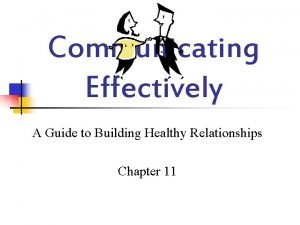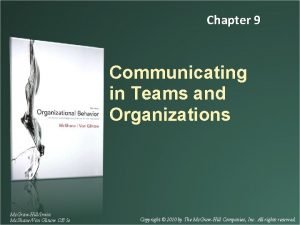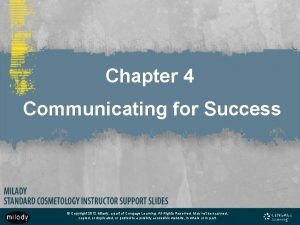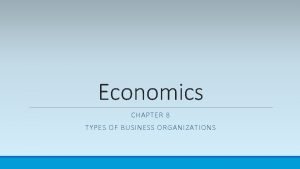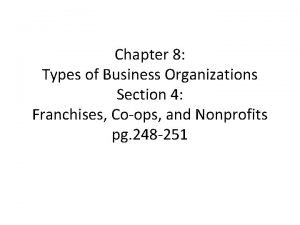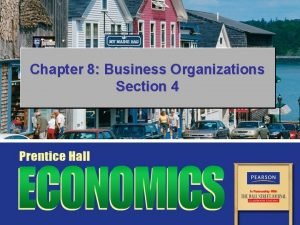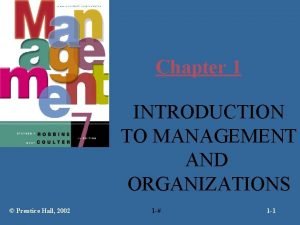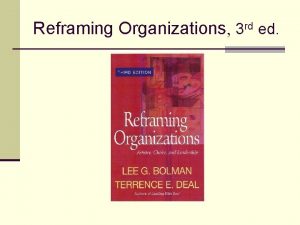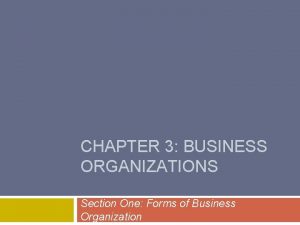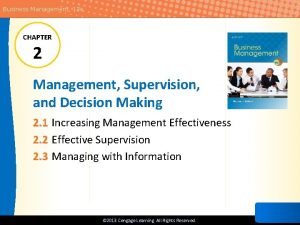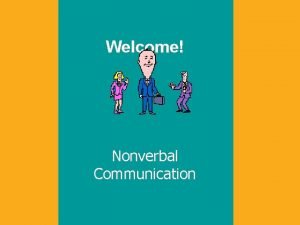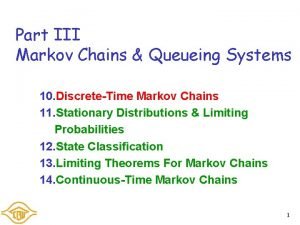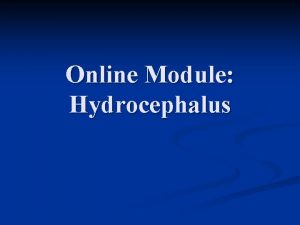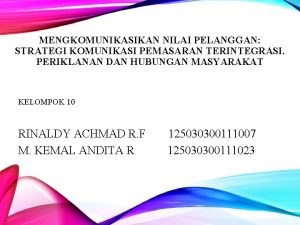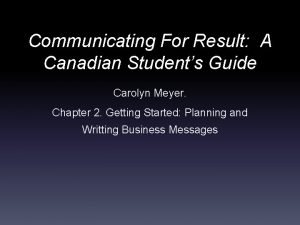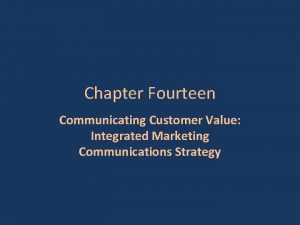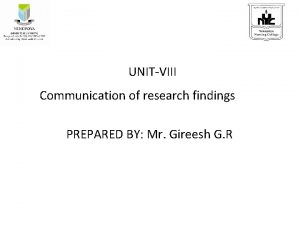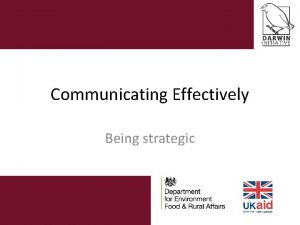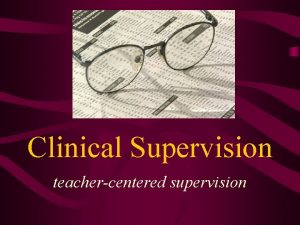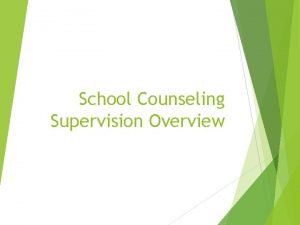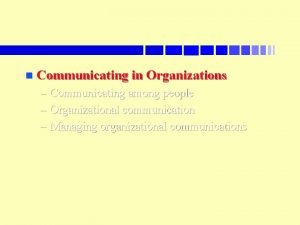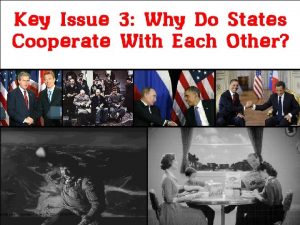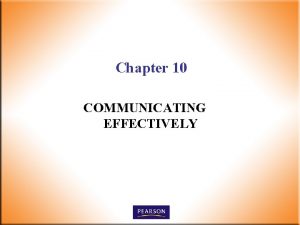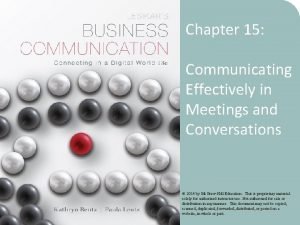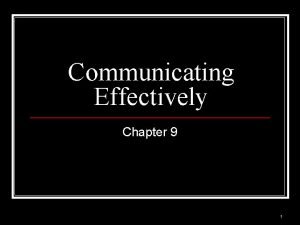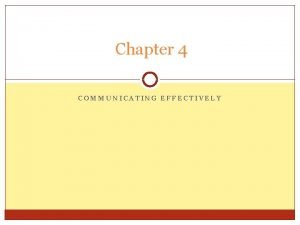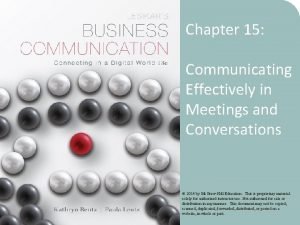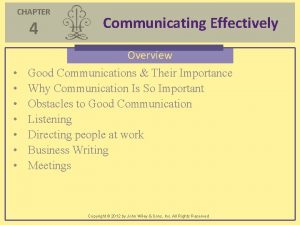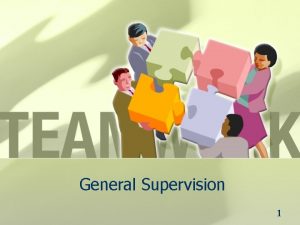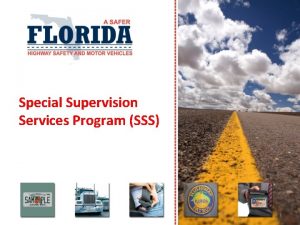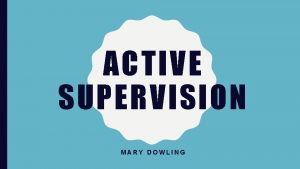Supervision in Organizations Chapter 10 Communicating Effectively 10























- Slides: 23

Supervision in Organizations Chapter 10 Communicating Effectively 10– 1

Learning Outcomes After reading this chapter, I will be able to: 1. Define communication and the communication process. 2. Contrast formal and informal communication. 3. Explain how electronic communication affects the supervisor’s job. 4. List the barriers to effective communication. 5. Describe techniques for overcoming communication barriers 6. List the requirements for active listening. 7. Explain the behaviors necessary for providing effective feedback. 10– 2

Communication defined… • Communication is the process by which people send and receive information: Ø It involves the transfer of meaning which must be understood to be successful 70 % or all our communication efforts are: misunderstood, misinterpreted, rejected, disliked, distorted, or not heard (in the same language, same culture)! 10– 3

What are the most common ways we communicate? d Wor n e Spok Written Word ag m I l a Visu es Bod y La ngu age 10– 4

The Goals of Communications: To change behavior To get and give Information To persuade To get action To ensure understanding 10– 5

Message Channels The five message channels 1. Face-to-Face 2. Face-to-group 3. Telephone 4. Written 5. Third Party 10– 6

The Communication Process • Communication process Ø The transferring and understanding of meaning 10– 7

Communication Process Terms • Encoding Ø Selecting words and their order for a message by a sender • Message Ø A purpose to be conveyed • Channel Ø The medium by which a message travels • Feedback Ø A verbal or nonverbal response by a receiver to the sender’s message • Noise Ø literally, or figuratively, anything that interferes with a message • Decoding Ø The translation of a message by a receiver 10– 8

Formal vs. Informal Communication • Formal communication Ø Communication that addresses task-related issues and tends to follow the organization’s authority chain Ø Examples: v Speech v Written documents v Electronic behavior • Informal communication (grapevine) Ø Communication moving in any direction, skips authority levels, and is likely to satisfy social needs 10– 9

Written Versus Verbal Communications • Written Ø Tangible Ø Verifiable Ø More permanent Ø More precise Ø More care is taken with the written word • Verbal Ø Less secure Ø Known receipt Ø Quicker response Ø Consumes less time Ø Quicker feedback 10– 10

Nonverbal Communications • Body language Ø Nonverbal communication cues such as facial expressions, gestures, and other body movements • Verbal intonation Ø An emphasis given to word or phrases that conveys meaning 10– 11

The Grapevine “The grapevine motto: Good information passes among people fairly rapidly—bad information, even faster!” • Grapevine Ø An unofficial channel of communication that is neither authorized nor supported by the organization. 10– 12

Grapevine: Rumors • Why Rumors Emerge Ø Ambiguity being present Ø As a response to situations that are important to us Ø Under conditions that arouse anxiety • Four purposes of Rumors Ø Reduce anxiety Ø Make sense of fragmented information Ø Serve as a vehicle to organize groups Ø To signal sender’s status (power) 10– 13

Barriers to Effective Communication Overcoming Barriers to Effective Communication • Lack of Honesty (lying) • Credibility gap • Language • Emotions • Listening Habits • Lack of Feedback • Perception • Information Medium • Thinking First • Use Feedback • Taylor Language to the receiver • Listen actively • Constrain Emotions • Watch Nonverbal Cues 10– 14

How to Improve Your Communication Effectiveness Steps for effective Communication: 1. Think First 2. Constrain Emotions 3. Learn to Listen 4. Taylor Language to the Listener 5. Match Words & Actions 6. Use Feedback 10– 15

Improving Your Communication Effectiveness Step #1: Think First (Focus your message) Ø Plan before you speak Ø Clarify your intent/goals of the communication v Inform, persuade, direct, decide… Ø Be specific Ø Be courteous and objective 10– 16

Focus Your Message: Example Unfocused Message q q q I need it soon. Why are you always late? You need to improve your productivity. Focused Message o I need it by 3 p. m. today. o I noticed you came to work 10 minutes late everyday this week. o I expect you to complete all assigned tasks by the end of the day today. 10– 17

Improving Your Communication Effectiveness • Step #2: Constrain Emotions Ø Emotions can cloud and distort transference of meaning Ø Tip: v If emotional, discontinue communication until you have regained composure 10– 18

Improving Your Communication Effectiveness Step #3: Learn to Listen Actively o RECEIVE – concentrate on what is being said (verbally and nonverbally) o PERCEIVE – paraphrase your understanding o DECODE – analyze and explore the situation to gain further understanding o RESPOND - Last – not first! Plan before you speak! 10– 19

Improving Your Communication Effectiveness Step #4: Tailor Language to the Receiver Ø Consider the person/audience to whom the message is directed Ø Simplify language Ø Be specific, use concrete terms Ø Use positive language Ø Use analogies 10– 20

Improving Your Communication Effectiveness • Step #5: Match Words & Action Ø Do what you say you’re going to do Ø Ensure that nonverbal cues match words v Nonverbal – Eyes – Gestures – Posture – Face indicators 10– 21

Improving Your Communication Effectiveness • Step #6: Use Feedback Ø Ask questions to prevent misunderstanding Ø Example: v When you thing that something is missing, ask simple, direct questions to get necessary information 10– 22

Suggestions for Effective Feedback • Focus on specific behavior • Keep feedback impersonal • Keep feedback goal oriented • Make feedback well-timed • Ensure understanding • Direct negative feedback towards behavior that the receiver can control 10– 23
 Short voicemail greetings personal
Short voicemail greetings personal Communicating vs non communicating hydrocele
Communicating vs non communicating hydrocele Healthy relationships communicating effectively
Healthy relationships communicating effectively Communicating in teams and organizations
Communicating in teams and organizations Milady client consultation form
Milady client consultation form Chapter 8 types of business organizations
Chapter 8 types of business organizations Chapter 8 section 4
Chapter 8 section 4 Chapter 8 business organizations
Chapter 8 business organizations Introduction to management chapter 1
Introduction to management chapter 1 Reframing organizations chapter 3 summary
Reframing organizations chapter 3 summary Chapter 3 information systems organizations and strategy
Chapter 3 information systems organizations and strategy Chapter 3 business organizations
Chapter 3 business organizations Chapter 2 management supervision and decision making
Chapter 2 management supervision and decision making Communicating without words
Communicating without words Aperiodic markov chain
Aperiodic markov chain Normal pressure hydrocephalus treatment
Normal pressure hydrocephalus treatment Model makro proses komunikasi
Model makro proses komunikasi Hydrocephalus ddx
Hydrocephalus ddx Communicating in the digital age workplace
Communicating in the digital age workplace Communicating for results a canadian student’s guide
Communicating for results a canadian student’s guide Communicating across cultures ppt
Communicating across cultures ppt Accounting is the language of business.
Accounting is the language of business. Communicating customer value
Communicating customer value Communication of research findings
Communication of research findings


